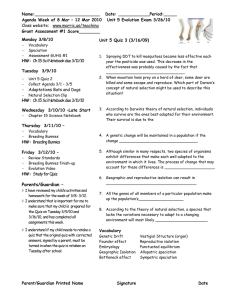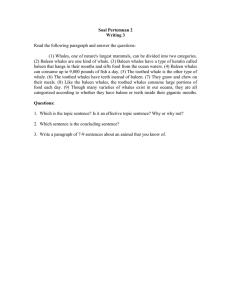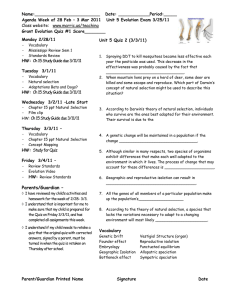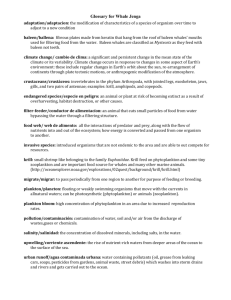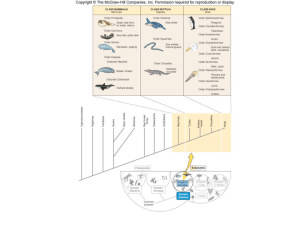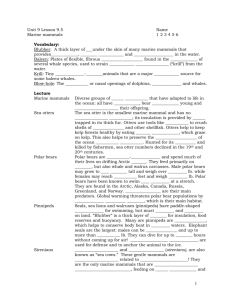Name:_________________________ Date: ____________Period:_____
advertisement
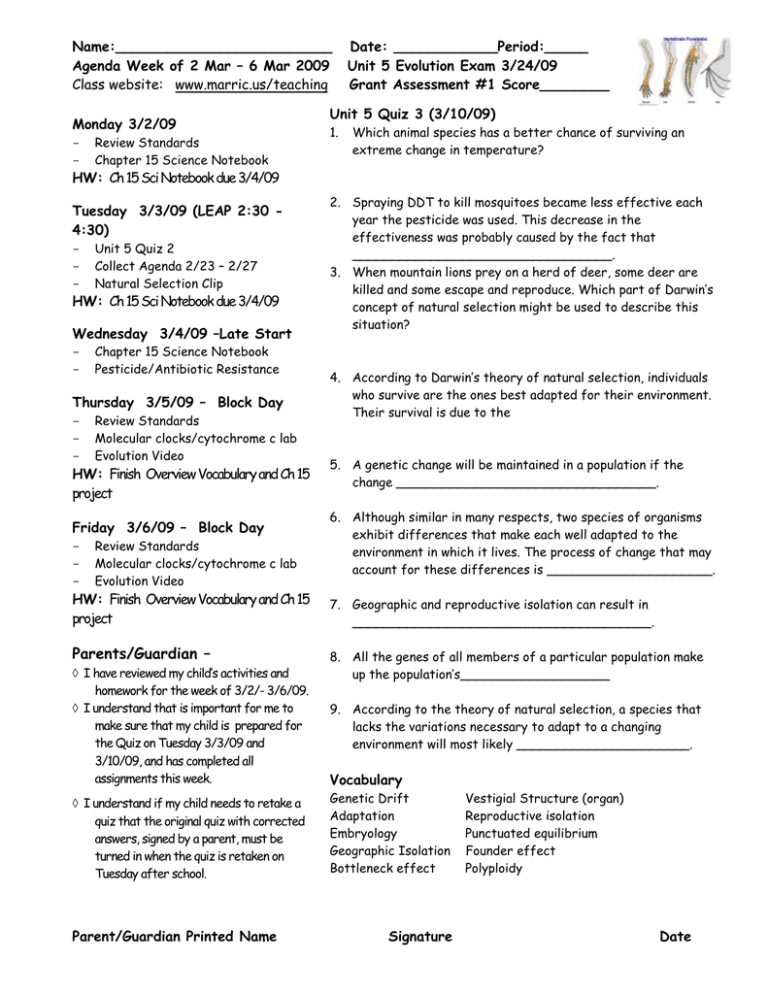
Name:_________________________ Agenda Week of 2 Mar – 6 Mar 2009 Class website: www.marric.us/teaching Monday 3/2/09 - Review Standards Chapter 15 Science Notebook Date: ____________Period:_____ Unit 5 Evolution Exam 3/24/09 Grant Assessment #1 Score________ Unit 5 Quiz 3 (3/10/09) 1. Which animal species has a better chance of surviving an extreme change in temperature? HW: Ch 15 Sci Notebook due 3/4/09 Tuesday 3/3/09 (LEAP 2:30 4:30) - Unit 5 Quiz 2 Collect Agenda 2/23 – 2/27 Natural Selection Clip HW: Ch 15 Sci Notebook due 3/4/09 Wednesday 3/4/09 –Late Start - Chapter 15 Science Notebook Pesticide/Antibiotic Resistance Thursday 3/5/09 – Block Day - Review Standards Molecular clocks/cytochrome c lab Evolution Video HW: Finish Overview Vocabulary and Ch 15 project Friday 3/6/09 – Block Day - Review Standards Molecular clocks/cytochrome c lab Evolution Video HW: Finish Overview Vocabulary and Ch 15 project Parents/Guardian – I have reviewed my child’s activities and homework for the week of 3/2/- 3/6/09. I understand that is important for me to make sure that my child is prepared for the Quiz on Tuesday 3/3/09 and 3/10/09, and has completed all assignments this week. I understand if my child needs to retake a quiz that the original quiz with corrected answers, signed by a parent, must be turned in when the quiz is retaken on Tuesday after school. Parent/Guardian Printed Name 2. Spraying DDT to kill mosquitoes became less effective each year the pesticide was used. This decrease in the effectiveness was probably caused by the fact that _________________________________. 3. When mountain lions prey on a herd of deer, some deer are killed and some escape and reproduce. Which part of Darwin’s concept of natural selection might be used to describe this situation? 4. According to Darwin’s theory of natural selection, individuals who survive are the ones best adapted for their environment. Their survival is due to the 5. A genetic change will be maintained in a population if the change _________________________________. 6. Although similar in many respects, two species of organisms exhibit differences that make each well adapted to the environment in which it lives. The process of change that may account for these differences is _____________________. 7. Geographic and reproductive isolation can result in ______________________________________. 8. All the genes of all members of a particular population make up the population’s___________________ 9. According to the theory of natural selection, a species that lacks the variations necessary to adapt to a changing environment will most likely ______________________. Vocabulary Genetic Drift Adaptation Embryology Geographic Isolation Bottleneck effect Signature Vestigial Structure (organ) Reproductive isolation Punctuated equilibrium Founder effect Polyploidy Date Bell Ringers: Week of 2 Mar – 6 Mar 2009 Monday – When mountain lions prey on a herd of deer, some deer are killed and some escape. Which part of Darwin’s concept of natural selection might be used to describe this situation? a. reproductive isolation c. survival of the fittest b. acquired characteristics d. descent with modification Explain Tuesday - True/False ________ Scientists believe that all living things, including daisies, crocodiles, and humans share a common ancestor. ________ A great number of species have died out since life first appeared on Earth. ________ The first mammals appeared on Earth at about the same time as the first terrestrial plants. Wednesday – A field of crops was sprayed with pesticides to control a population of insects that was eating the crop. Only 1% of the insects survived. The same amount and type of pesticide was sprayed on the field each year for the next 4 years. The graph shows the percentage of insects that survived each year after the pesticide was used. Why was the pesticide less effective each year in its ability to control the target population of insects? Thursday/Friday Comparisons are made between two different organisms by finding the place where the two lines intersect. The number where the columns and rows intersect shows how many amino acids are different in the cytochrome c of both organisms. For example, the number of amino acids that are different when comparing a rabbit's cytochrome c with a tuna's cytochrome c is 17. The larger the number, the greater the difference in the structure of the cytochrome c molecules of the two organisms. What is the relationship between: turtle and monkey tuna and rattlesnake chicken and rabbit duck and kangaroo tuna and turtle rabbit and pig kangaroo and rabbit turtle and duck Which pair of organisms is least closely related? Which of these pairs of organisms is most closely related? Name:_______________________________ Date:____________________ Period:______ Unit 5 Quiz 3 March 10, 2009 1. Although similar in many respects, two species of organisms exhibit differences that make each well adapted to the environment in which it lives. The process of change that may account for these differences is _____________________. 2. The idea that evolution takes place at one point in time, followed by a long period without change is 3. When mountain lions prey on a herd of deer, some deer are killed and some escape and reproduce. Which part of Darwin’s concept of natural selection might be used to describe this situation? 4. In order for a species to survive, it must be able to _________________ a) consume a wide variety of food c) maintain a constant body temperature b) reproduce successfully d) destroy competing species 5. Which animal species has a better chance of surviving an extreme change in temperature? a. b. c. d. One with no fur. One with different colors of fur and the same length of fur. One with the same color of fur and the same length of fur. One with different colors of fur and different lengths of fur. 6. Spraying DDT to kill mosquitoes became less effective each year the pesticide was used. This decrease in the effectiveness was probably caused by the fact that _________________________________. 7. According to Darwin’s theory of natural selection, individuals who survive are the ones best adapted for their environment. Their survival is due to the_______________________ __________________________________________________________________ 8. A genetic change will be maintained in a population if the change _______________________________________________________________. 9. Geographic and reproductive isolation can result in ____________________________. 10. All the genes of all members of a particular population make up the population’s____________ 11. The idea that evolution takes place at a continuous but very slow rate is known as ___________________________. 12. According to the theory of natural selection, a species that lacks the variations necessary to adapt to a changing environment will most likely — A become dormant B mutate C become extinct D fossilize ________________________ A. The genetic contribution of an individual to succeeding generations. ________________________ B. Two populations are isolated if their members are unable to interbreed and produce fertile offspring. Structural, behavioral, and biochemical features can prevent interbreeding and thus isolate populations as distinct species. ________________________ C. a branch of biology dealing with embryos and their development ________________________ D. A peculiarity of structure, physiology, or behavior that aids the organism in its environment ________________________ E. The separation of populations by barriers such as rivers, mountains, or bodies of water. ________________________ F. A type of homologous structure that is rudimentary and of marginal or no use to the organism. ________________________ G. An effect of genetic drift attributable to colonization by a limited number of individuals from a parent population. ________________________ H. An effect of genetic drift attributable to a temporary reduction in population size. ________________________ I. occurs in cells and organisms when there are more than two homologous sets of chromosomes and is a mechanism of speciation. Reproduction of these animals can occur asexually by parthenogenesis. ________________________ J. Changes in the gene pool of populations due to chance. ________________________ K. A theory of evolution advocating spurts of relatively rapid change followed by long periods of stasis. ________________________ L. The origin of new species in evolution. Reproductive isolation Founder effect Speciation Vestigial Structure Punctuated equilibrium Embryology Fitness Polyploidy Geographic Isolation Adaptation Genetic Drift Bottleneck effect Extra Credit ________In the early stages of development, the embryos of dogs, pigs, and humans resemble one another. This observation suggests that these animals may have _______. a. the same blood components c. similar habitat requirements b. a common ancestry d. a similar number of chromosomes ________Which of these would most likely cause a mutation? a. the release of messenger RNA from DNA b. the placement of ribosomes on the endoplasmic reticulum c. the movement of transfer RNA out of the nucleus d. the insertion of a nucleotide into DNA a) b) During the fall reproductive season, the belly of a male brook trout becomes bright orange. The orange belly provides some camouflage and helps attract females. This trait evolved in brook trout because, compared to males with pale bellies, males with bright orange bellies are more likely to A. live in good habitats. B. be eaten by predators. C. mate with other species of fi sh. D. fertilize eggs to produce offspring. c) There are two types of modern whales: toothed whales and baleen whales. Baleen whales filter plankton from the water using baleen, plates made of fibrous proteins that grow from the roof of their mouths. The embryos of baleen whales have teeth in their upper jaws. As the embryos develop, the teeth are replaced with baleen. Which of the following conclusions is best supported by this information? A. Primitive whales had teeth as adults. B. Toothed whales descended from baleen whales. C. Baleen whales are evolving into toothed whales. D. Descendants of modern baleen whales will have both teeth and baleen as adults.
